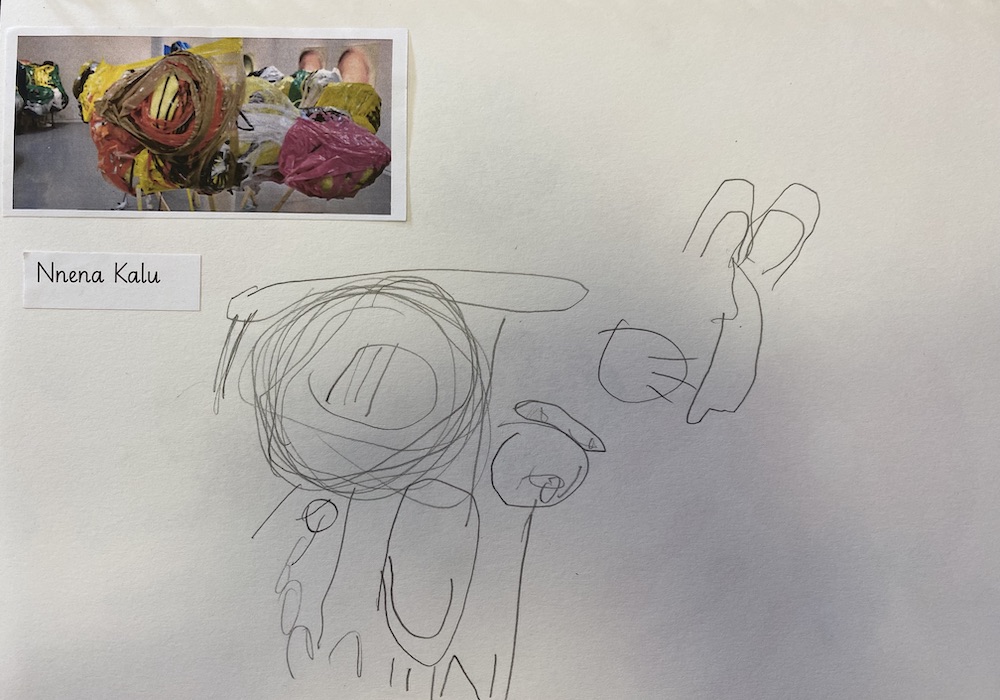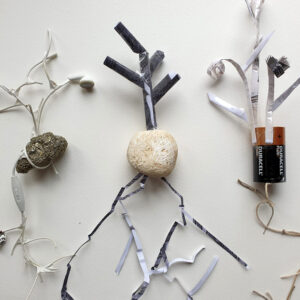Adapting AccessArt: Playful Making Inspired by Nnena Kalu
By Lorna Greenwood
In this post Lorna Greenwood, Teaching assistant and Art specialist at St Teresa’s Roman Catholic Primary School, shares with us how she used the Primary Art Curriculum pathway ‘Playful Making’ for a year one class (ages 5-6) and adapted the AccessArt resource to develop collaborative sculpture.

Session One:
The children at this age really love watching the video resources. We started by watching the ‘Introducing Sculpture’ video from which their inquisitive minds had plenty of questions. We discussed scale and materials before moving onto looking at the artist Linda Bell. They were excited by the idea that her sculptures are supposed to be explored through collaboration, touch and play. They reflected on her work through questioning using the talking points resource and commented how they wanted to be part of her work.
We then moved onto Nnena Kalu, again watching the video resources. I asked the pupils what could they see? Did it remind them of anything? And how did it made them feel? These questions were taken from the Talking Points resource, however rather than rhythm and pace questions that were suggested, I asked them to consider the movements she made when making her works. Pupils were asked to mimic this action in the air. We discussed this action and how it was repetitive, linking it to our previous pathway ‘Simple Printing’.
I then froze our interactive whiteboard to hold a still of one of Nnena’s works to carry out a ‘Show Me What You See’ activity. Children sometimes contain their drawings to a small area and can find it challenging to work bigger. To encourage them to use the whole page I always give examples, a quick sketch of a tiny picture on a page compared to an image that fills the page; I have the children tell me which is more effective. I encourage them to look at what they are going to draw to help them select landscape or portrait orientation. They hold their sketchbooks up to show me their choice before we start.
 When we set to drawing, I encouraged them to look out for the main shapes or lines within the image and where they are placed within the image, to help with placement on their page. We took it step by step to place these main features and as their work progressed I could point out smaller details and encouraged them to point out things they have noticed too. The repeated rhythm of Nnena’s binding technique really helped the children understand how to make marks to replicate her work in a drawing.
When we set to drawing, I encouraged them to look out for the main shapes or lines within the image and where they are placed within the image, to help with placement on their page. We took it step by step to place these main features and as their work progressed I could point out smaller details and encouraged them to point out things they have noticed too. The repeated rhythm of Nnena’s binding technique really helped the children understand how to make marks to replicate her work in a drawing.





Session Two:
Continuing to follow the pathway, I used the ‘Prompt Cards for Making’ resource, however, I was selective with which prompt card I gave the children for the next activity ‘Design Through Making’. I chose the prompts: ‘Make Something which Balances’, ‘Make Something which Contains Something Else’, ‘Make a Family of Things’ and ‘Make Something which Stands on 3 Points’.
In our setting we have four tables seating eight at each, so I found it reasonable to use just four cards, one per table. I added a tray to each table containing a range of materials; paper plates, string, wire, tape, blu-tack, art straws, plastic cutlery, pipe cleaners, scissors, glue, card, bubble wrap, wool, sellotape and masking tape to name a few.
To manage this activity without interrupting their own learning through doing, I set ground rules before they started. Their table equipment was for their table only; they were to share with others on their table and were shown how to use equipment such as scissors and wire safely. Once I had explained each tables task, they were able to independently explore and make, with only a few prompts or suggestion from myself. The children, who can be quite chatty when undertaking provision to my surprise were extremely quiet. Their concentration and eagerness to understand the materials and how they worked with one another was astonishing.




Session Three:
I collected and prepared a range of materials appropriate to recreate their own versions of Nnena Kalu’s sculptures. This included bubble wrap, a large roll of craft paper however parcel paper would work just as well, cut down bamboo poles to use as legs if required, masking tape and a range of different coloured electrical tapes. The more tape the better as they get through it quickly!
Before they undertook the activity we talked about the repetitive actions Nnena used when creating her work and demonstrated how to bind a ball of bubble wrap. Their only prompt for their outcome was to create their own Nnena Kalu inspired sculpture. I suggested creating individually bound items to then connect together but it was ultimately up to each team how they worked together.
I reminded them again about their tables equipment, sharing, safety when using scissors and working as a team. They were eager to get going and their concentration throughout the activity was clear to see. Pupils were praised throughout for their teamwork and how they communicated instructions to one another was exemplary. Their development of working with a range of materials had clearly improved again through the design through making process.
Each team was asked to display their final sculptures on their table and tidy their area.

The children were very proud of their work and so we displayed it on the school corridor for the rest of the school to see.
Pupils continued the Playful Making pathway over the next 3 sessions, choosing to follow the Creativity Medals project just in time for our sports day celebrations.














